You can create perfect herbal tea blends with a mix of innovative cold techniques that elevate flavor and freshness. Start with quality organic ingredients and know the ideal ratios: 50% base herbs, 30% supporting herbs, and 15% flavoring herbs. Use cold water brewing or try the cold brew method for a subtle, smooth taste. Experiment with infusions lasting from a few hours to overnight, and don't forget to add sweeteners like honey or agave for extra zing. Finally, chill your glassware and garnish with citrus slices to impress. There's much more to explore about crafting your perfect brew.
Understanding Herbal Tea Basics

Herbal teas are more than just a comforting drink; they're a diverse domain of flavors and benefits. When you immerse yourself in the sphere of herbal teas, you'll find an array of plants, flowers, and spices, each offering unique characteristics.
Unlike traditional teas, herbal teas are caffeine-free, making them an excellent choice for any time of day. You've got options ranging from soothing chamomile to invigorating peppermint, each with its own set of health advantages.
Understanding the basics involves knowing that herbal teas can be made from almost any part of a plant—roots, leaves, seeds, or flowers. They're typically steeped in hot water, extracting flavors and beneficial compounds, and you can enjoy them hot or cold.
The steeping time can vary, usually between five to ten minutes, depending on the herbs used. Experimenting with different blends allows you to discover what you love. You might enjoy a calming blend for relaxation or a zesty mix for a revitalizing boost.
No matter your choice, you're opening a door to countless flavors and wellness benefits that can enhance your daily routine.
Selecting Quality Ingredients
When you're crafting the perfect herbal tea blend, the quality of your ingredients matters immensely.
You'll want to source fresh herbs, consider whether organic options are worth it, and make sure you store everything properly to maintain flavor and potency.
Let's explore how each of these factors can elevate your tea experience.
Sourcing Fresh Herbs
Selecting quality ingredients is essential for creating delightful herbal tea blends. When you source fresh herbs, you're not just picking any leaves; you're choosing the foundation of your tea's flavor and health benefits. Look for herbs that are vibrant in color, fragrant, and free from any signs of wilting or browning. Freshness directly impacts the aroma and taste of your blends.
To help you in your quest for the best herbs, here's a simple guide:
| Herb | Aroma | Best Time to Harvest |
|---|---|---|
| Mint | Sweet, cooling | Morning |
| Basil | Sweet, peppery | Late morning |
| Chamomile | Floral, calming | Early afternoon |
| Lemon Balm | Citrus, fresh | Morning |
Organic vs. Conventional
Which type of herbs do you prefer in your tea blends—organic or conventional? This choice can notably impact the quality and flavor of your herbal teas.
Organic herbs are grown without synthetic pesticides or fertilizers, which means you're likely to enjoy a purer taste and experience fewer chemicals in your cup. When you choose organic, you also support sustainable farming practices that benefit the environment.
On the other hand, conventional herbs might be more accessible and budget-friendly. They can still offer great flavors, especially if you select high-quality brands. However, it's essential to research where your herbs come from, as some conventional practices can involve chemical treatments that may affect both taste and health.
To make the best choice, consider your priorities. If you're focused on health and sustainability, organic is the way to go.
But if you're on a budget, don't hesitate to explore conventional options while paying attention to sourcing and quality. Ultimately, the best herbs for your tea blends will depend on your personal preferences, values, and goals for your herbal tea experience.
Proper Storage Methods
To keep your herbal tea blends fresh and flavorful, proper storage methods play an essential role in maintaining quality ingredients.
First, always store your tea in a cool, dark place. Light and heat can degrade the delicate flavors and aromas of your herbs, so avoid placing them near the stove or in direct sunlight.
Use airtight containers to protect your blends from moisture and air exposure. Glass jars with tight-sealing lids or opaque tins work well.
Make sure to label your containers with the blend name and date, so you can keep track of freshness.
Keep your blends away from strong odors, as herbs can easily absorb scents from nearby foods or spices.
For longer-term storage, consider vacuum-sealing your blends to extend their shelf life.
Lastly, check the quality of your ingredients regularly. If you notice any off smells, discoloration, or loss of aroma, it's time to replace them.
Ideal Herbal Ratios

Finding the right herbal ratios can make all the difference in creating a balanced and flavorful tea blend. To craft a delightful infusion, you want to verify that no single herb overpowers the others.
Start by experimenting with different combinations, keeping in mind that each herb brings unique properties and flavors to the table.
Here are some ideal ratios to take into account:
- Base Herbs (50%): Use robust herbs like chamomile or peppermint as your primary foundation.
- Supporting Herbs (30%): Add herbs like lemon balm or hibiscus to enhance and complement your base.
- Flavoring Herbs (15%): Incorporate aromatic herbs such as ginger or cinnamon for a touch of warmth.
- Specialty Herbs (5%): Include rare or medicinal herbs like echinacea or nettle for health benefits.
Adjust these ratios based on your taste preferences and desired effects.
Remember, it's all about balance. Keep a journal of your experiments to refine your blends over time.
With practice, you'll become adept at creating herbal tea blends that tantalize your taste buds and provide the soothing experience you seek.
Cold Brew Method Overview
After perfecting your herbal ratios, you might want to explore different brewing techniques, and cold brewing is a fantastic option. This method allows you to extract the delicate flavors and aromas of your herbs without the bitterness often associated with hot water. It's simple and requires minimal effort.
To start, gather your chosen herbal blend and place it in a jar or pitcher. You'll want to use a higher quantity of herbs than you'd for hot brewing, as the cold water extracts flavors more slowly.
Next, fill the container with cold or room temperature water. Make sure the herbs are fully submerged, then seal the container tightly.
Once it's prepared, you can let it steep in the refrigerator for an extended period—typically anywhere from 6 to 12 hours. This slow infusion process draws out the subtle nuances of your herbs, resulting in a smooth and invigorating tea.
When you're ready, strain out the herbs and enjoy your cold brew over ice or as a base for other beverages. Cold brewing offers a unique flavor profile, making it a delightful addition to your herbal tea repertoire.
Infusion Time Guidelines
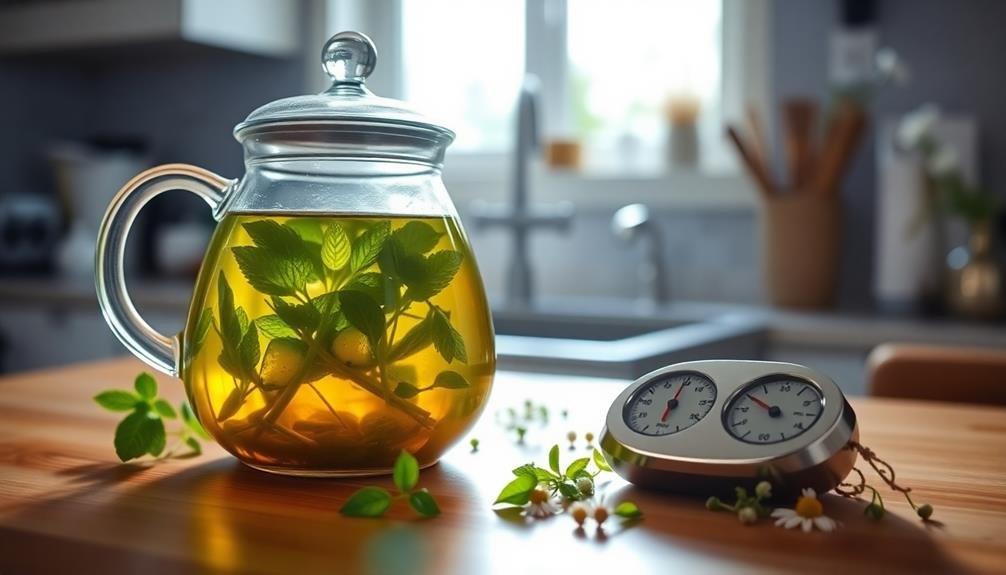
Infusion time plays a crucial role in determining the flavor and strength of your herbal tea blends. Getting this timing right can elevate your tea experience, while too short or too long can lead to disappointing results.
Generally, you can follow these guidelines for ideal infusion times based on the type of herbal ingredients you're using.
- Flowers (e.g., chamomile): 4-6 hours for a delicate flavor
- Leaves (e.g., mint): 6-8 hours for a rejuvenating taste
- Roots (e.g., ginger): 8-12 hours for a robust flavor
- Barks (e.g., cinnamon): 12-24 hours for a deep, rich infusion
Experimenting with different infusion times can help you discover your perfect balance.
Remember, the longer you steep, the stronger the flavor becomes. If you find your tea too bitter or overpowering, try reducing the infusion time.
Keep track of your results, and don't hesitate to tweak your approach based on your preferences. With these guidelines, you're well on your way to mastering the infusion process for your herbal blends!
Flavor Pairing Techniques
When you're crafting your herbal tea blends, pairing flavors effectively can make all the difference in your final brew. Start by contemplating complementary flavors that enhance each other. For instance, if you're using a strong base like peppermint, try pairing it with milder herbs like chamomile or lemongrass. This balance allows each flavor to shine without overpowering the others.
Next, think about contrasting flavors. A zesty citrus note, like orange peel, can brighten up earthier herbs, such as rooibos or hibiscus. This contrast creates a dynamic profile that keeps your palate intrigued. You can also incorporate spices for warmth and depth; cinnamon works beautifully with fruity blends, while ginger adds a kick to floral notes.
Don't forget to contemplate aroma as well. Scents can influence how we perceive taste, so pairing aromatic herbs like lavender with sweeter herbs can create a more immersive experience.
Experimenting With Sweeteners

Enhancing your herbal tea blends doesn't stop at flavor pairing; sweeteners play a significant role in shaping the overall taste experience. Experimenting with different sweeteners can elevate your tea, balancing the natural flavors of the herbs.
You've got various options to contemplate, each bringing its unique characteristics.
- Honey: Adds a floral sweetness that complements most herbal blends.
- Stevia: A calorie-free option that offers intense sweetness without impacting flavor.
- Agave nectar: With a mild taste, it's perfect for those seeking a lighter sweetness.
- Maple syrup: This adds a rich, earthy flavor that can enhance spiced herbal blends.
Don't hesitate to mix and match these sweeteners to find your perfect combination. You might discover that a little honey enhances your chamomile tea, while a splash of maple syrup takes your chai to new heights.
Chilling and Serving Tips
Enjoyment is key when it comes to serving herbal tea, especially when you want to chill it for those warm days. Start by brewing your favorite herbal tea blend and allow it to cool to room temperature. Once cooled, pour it into a pitcher, add ice, and garnish with fresh herbs or slices of citrus for an extra invigorating touch.
Here are some quick chilling tips to elevate your tea experience:
| Tip | Description | Benefits |
|---|---|---|
| Use Cold Water | Brew with cold water overnight. | Enhances flavor profile. |
| Ice Cube Infusion | Freeze tea in ice cube trays. | Keeps tea cold without dilution. |
| Chill Glassware | Refrigerate your glasses beforehand. | Guarantees tea stays cold longer. |
| Citrus Zest | Add lemon or lime zest before serving. | Increases freshness and aroma. |
These simple techniques will help you serve perfectly chilled herbal tea that's both delicious and invigorating. Keep experimenting to find your ideal blends and serving methods!
Storing Your Blends
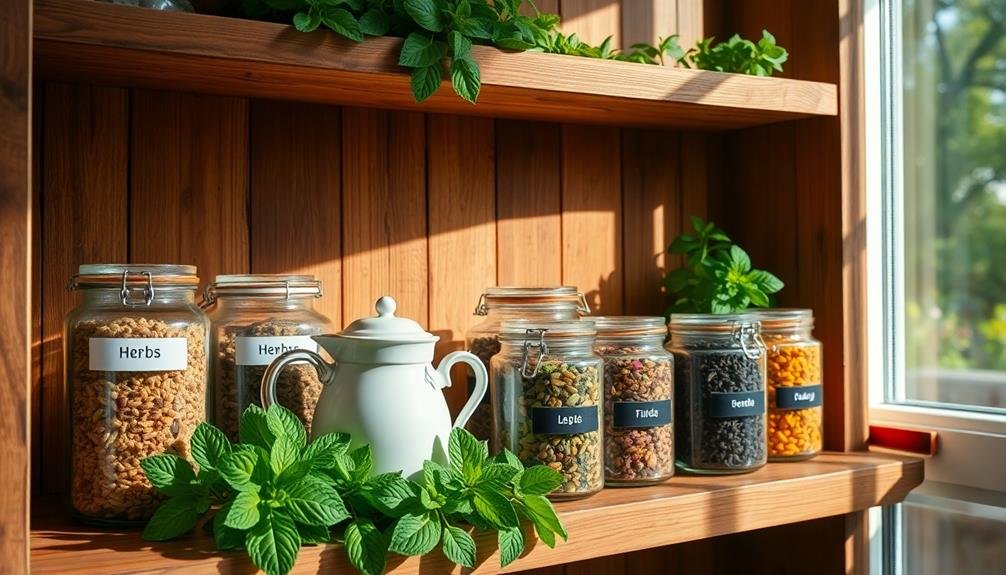
Proper storage of your herbal tea blends is essential to preserve their vibrant flavors and aromas. When you invest time and effort into creating unique blends, you want to guarantee they stay fresh for as long as possible.
Here are some key tips to help you store your blends effectively:
- Use airtight containers: Glass jars or metal tins with tight-fitting lids work best, as they keep moisture and air out.
- Keep away from light: Store your containers in a dark cupboard or pantry to prevent sunlight from degrading the herbs.
- Maintain a cool temperature: Avoid placing your blends in warm areas like above the stove. A cool, dry place is ideal.
- Label your blends: Write the date and ingredients on your containers, so you know when you made them and what's inside.
Customizing for Health Benefits
When you customize your herbal tea blends, you can target specific health benefits that align with your wellness goals.
By balancing flavor and health properties, you'll create a satisfying tea that supports your needs.
Personalizing your blends not only enhances your experience but also empowers you to take charge of your health.
Targeted Herbal Properties
Customizing herbal tea blends to target specific health benefits can enhance your overall well-being. By selecting the right ingredients, you can create teas that support your health goals.
Whether you're looking to boost your immunity, improve digestion, or promote relaxation, the right combination of herbs can make a significant difference.
Here are some targeted herbal properties to take into account when crafting your blend:
- Chamomile: Known for its calming effects, it can help reduce stress and promote better sleep.
- Peppermint: Excellent for digestion, it can relieve bloating and discomfort after meals.
- Echinacea: A powerful immune booster, it's great for warding off colds and infections.
- Ginger: Anti-inflammatory and antioxidant-rich, it can ease nausea and support overall health.
Flavor and Health Balance
Balancing flavor and health benefits in your herbal tea blends is essential for creating a delightful and effective brew. You want your tea to not only taste great but also provide the wellness boost you're seeking. Start by identifying the flavors you enjoy and consider how they can complement your health goals.
Here's a quick reference table to help you find harmonious pairings:
| Flavor Profile | Health Benefit |
|---|---|
| Mint | Aids digestion |
| Chamomile | Promotes relaxation |
| Ginger | Boosts immunity |
| Lemon Balm | Reduces stress and anxiety |
| Hibiscus | Supports heart health |
When crafting your blend, think about how these flavors can work together. For instance, if you love the invigorating taste of mint, combining it with ginger can provide a zing while enhancing your immune system. Experiment with ratios until you find that perfect balance where flavor and health benefits coexist seamlessly. Remember, taste and wellness don't have to be mutually exclusive; you can enjoy both in every sip.
Personalization for Wellness Goals
Personalizing your herbal tea blends for specific wellness goals can transform your daily routine into a tailored health experience. By selecting the right herbs and ingredients, you can create blends that not only taste great but also support your individual health needs.
Whether you're looking to boost your immunity or relax after a long day, customizing your tea is the way to go.
Here are some ideas to help you get started:
- Stress Relief: Incorporate herbs like chamomile or lavender to calm your mind and body.
- Immunity Boost: Use ingredients like echinacea and elderberry to support your immune system.
- Digestive Health: Add peppermint or ginger to soothe your stomach and improve digestion.
- Energy Boost: Blend green tea or yerba mate for a natural energy lift without the jitters.
Experiment with different combinations to find what works best for you.
Remember, the beauty of herbal tea lies in its versatility. By customizing your blends, you'll not only enjoy a delicious beverage but also promote your overall wellness in a way that feels uniquely yours.
Frequently Asked Questions
Can I Use Dried Herbs for Cold Brewing Herbal Tea?
Yes, you can definitely use dried herbs for cold brewing herbal tea. Just steep them in cold water for several hours, and you'll enjoy a flavorful, invigorating drink without any heat involved.
How Long Can I Store Brewed Herbal Tea in the Fridge?
You can store brewed herbal tea in the fridge for about 3 to 5 days. Just make sure it's in an airtight container to keep its flavor fresh and prevent any unwanted odors.
What Are the Best Containers for Cold Brewing Tea?
When cold brewing tea, opt for glass jars or pitchers, as they're non-reactive and prevent unwanted flavors. BPA-free plastic containers work too, but avoid metal, which can alter the taste of your brew.
Are There Any Herbs to Avoid When Cold Brewing?
When cold brewing, you should avoid herbs like chamomile and peppermint. They can become overly bitter or lose their delicate flavors. Instead, focus on milder herbs that maintain their essence when brewed at lower temperatures.
Can I Mix Herbal Teas With Traditional Teas for Cold Brewing?
Yes, you can mix herbal teas with traditional teas for cold brewing. Just make sure the flavors complement each other. Experimenting with different combinations will help you find your perfect blend that suits your taste.
In Summary
Now that you've got the scoop on creating perfect herbal tea blends, it's time to put your newfound knowledge to the test! With the right ingredients, ratios, and techniques, you can craft delicious, invigorating brews. Don't hesitate to experiment with flavors and sweeteners to find your ideal mix. Remember, storing your blends properly will keep them fresh for future enjoyment. So, grab your favorite herbs and start brewing—you're on your way to herbal tea perfection!

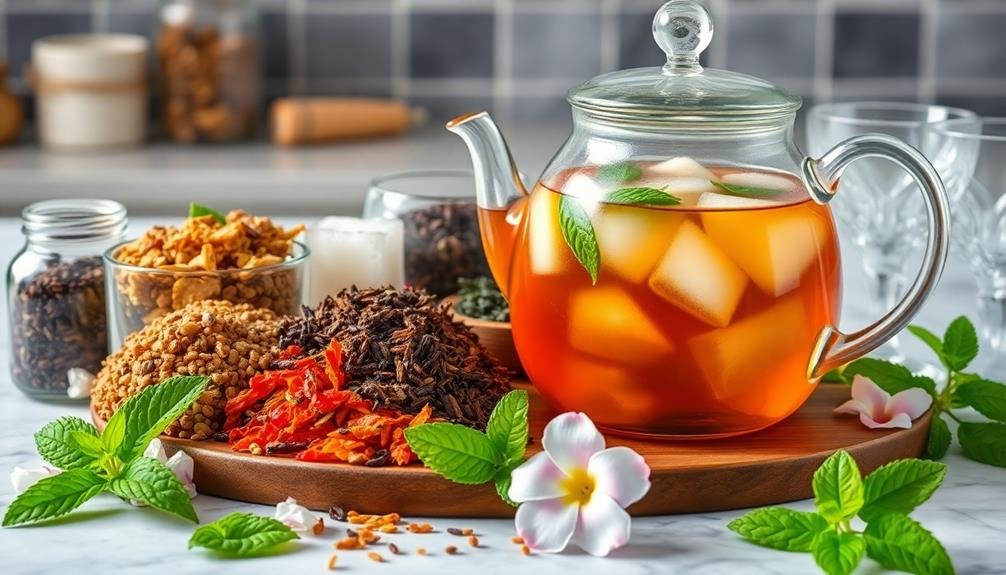
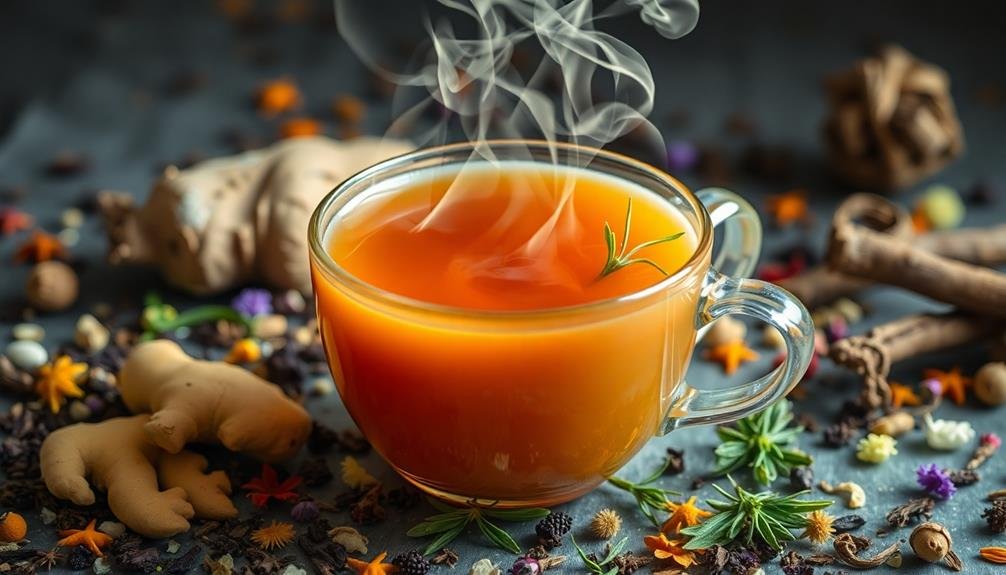
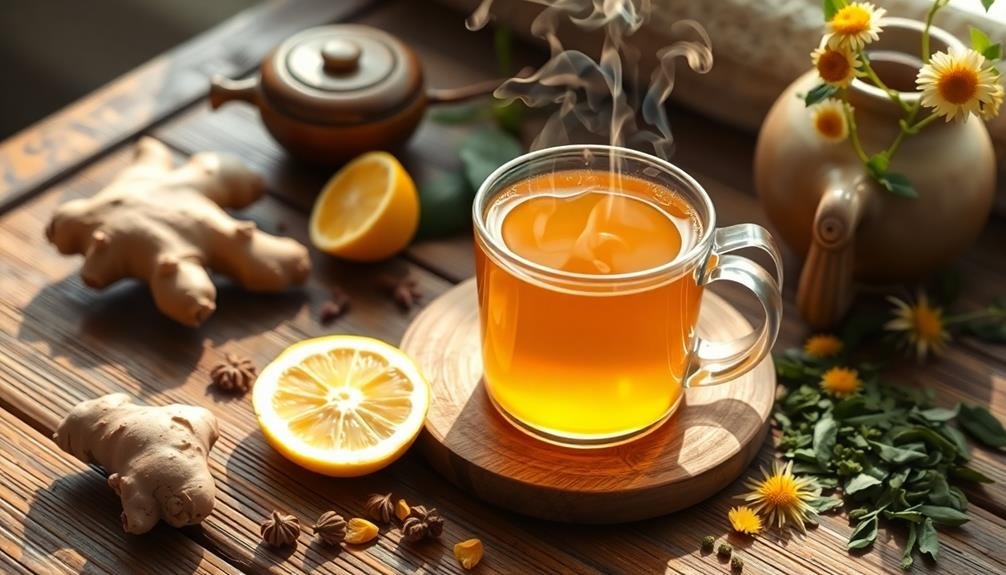
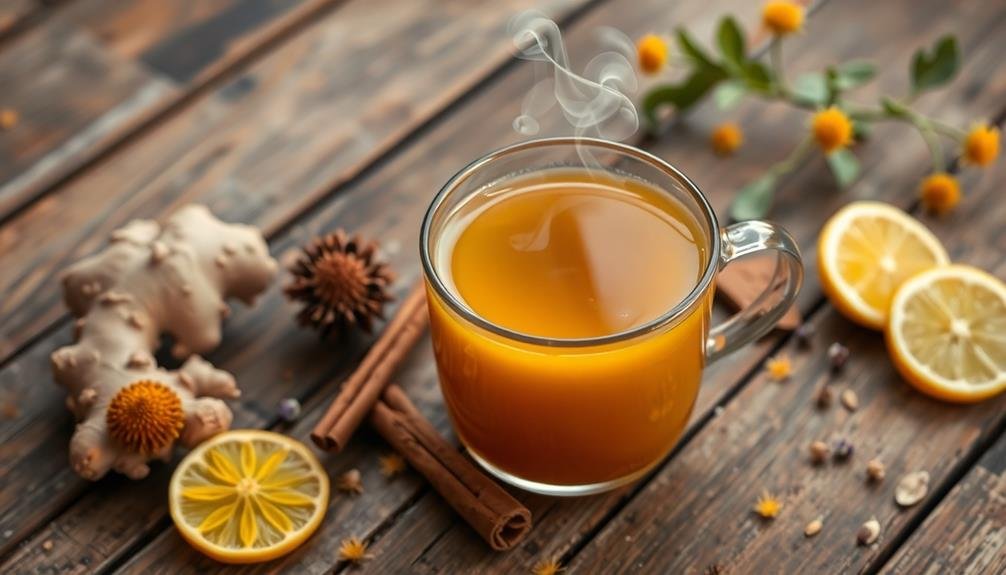
Leave a Reply